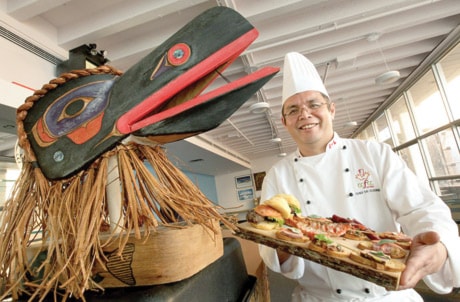Visitors at the 2010 Olympics could be eating their way through Canada and the world as they sprint from pavilions featuring the country’s regional cuisine to ethnic restaurants offering international fare.
Each of Canada’s provinces and territories will showcase their turf to a global audience at various pavilions sprinkled throughout downtown Vancouver, with many featuring their culinary delights.
From B.C. wild salmon to succulent Alberta beef, Saskatchewan sausage and Ukranian-influenced perogies to award-winning cheeses at Quebec House, East Coast seafood at Atlantic House and cuisine at the Four Host First Nations Pavilion, there’s something for every chowhound.
The latter pavilion, so named because the Games are being held on the traditional and shared territory of four aboriginal groups, will feature food from First Nations from across Canada, with an impressive menu created by senior chefs Andrew George Jr. and Arnold Olson.
In 1992, George Jr. and Olson were teammates with the first aboriginal group from any country to compete at the World Culinary Olympics in Germany, where they won seven gold, two silver and two bronze medals.
Now the two have reunited to present their creative flair to a global audience at the 2010 Winter Olympics.
“They’ll have a unique experience that is truly Canadian and truly aboriginal,” George Jr. said of foodies who will experience a feast of First Nations food.
“It’s a very old traditional cuisine that we’re exposing on the world stage,” he said, adding he and his partner have created a few new twists to centuries-old First Nations cuisine by fusing it with French and other cooking techniques.
The pavilion’s gastronomic delights will include a variety of dishes, some made with meats such as buffalo from the Prairies, caribou from the Yukon, the Northwest Territories and northern Quebec and venison from Ontario and the Interior of British Columbia.
Saskatchewan berries, wild rice, partridge, muskox, elk, bison, wild boar served with eggs Benedict and seafood such as smoked trout, salmon and Arctic char are sure to delight food lovers from near and far.
George will also make a unique vinaigrette from the sap of pine trees, which was traditionally harvested by First Nations as a form of sugar, and combine it with red wine vinegar, olive oil and shallots.
Different types of bannock, traditional fried bread that can also be baked and varies from region to region, will be used in canapes.
“Don’t panic, there’s lot of bannock,” he said.
At Atlantic House, which will feature the cuisine of Newfoundland and Labrador, Nova Scotia, New Brunswick and Prince Edward Island, lobster, halibut, scallops and other seafood will headline meals influenced by East Coast flavours.
Besides the cheese-inspired meals that will be served at Quebec House, visitors can treat themselves to French fare including tourtiere, a traditional meat pie, and of course, poutine, that classic la belle province fast food consisting of French fries with cheese curds and smothered in gravy.
Outside the pavilions, Games goers hankering for ethnic cuisine have a world of choices in Vancouver, with Indian, Asian and Japanese restaurants among the most popular.
For a plethora of choices in Asian cuisine, considered the best in the world, Olympic fans will want to jump on the Canada Line rapid transit train for a 25-minute trip from downtown to Richmond, B.C., home of Canada’s largest Chinese population.
If coffee’s the beverage of choice for Vancouverites, then sushi is a food many can’t live without. For many, the love affair began with the creations of celebrated chef Hidekaza Tojo, whose Tojo’s restaurant over the bridge from the downtown core regularly draws rave reviews.
Not far from those digs, Indian food lovers can count on chef Vikram Vij, whose top-rated Vij’s restaurant has been touted as the best in North America.
For meals on the run, Games visitors hunting for street meat will find the hugely successful Japadog stands a marvel to behold — if just for the lineups.
Noriki Tamura, 35, opened his first stand on a downtown corner in 2005, turning the humble hot dog into a classy and original meal. A second Japadog sidewalk cart followed last year.
“I didn’t have enough money so I couldn’t open a restaurant,” said Tamura, a former ad man from outside Tokyo.
He said his top dog is the Terimayo, which comes loaded with teriyaki sauce, Japanese mayonnaise, seaweed and fried onions.
His other creations include hot dogs adorned with grated white radish, plum sauce, edamame and fried cabbage.
Tamura recently added the Mau Dog, named after Japanese figure skater Mao Asada and decked with Japanese yuba — dried soy “that looks like gold medal.”
Now Tamura wants to impress Olympic guests at his new restaurant which will be under construction almost right up to the opening ceremonies.
For fresh-food folks, the Granville Island public market, about a 20-minute walk from downtown, is the place to be for produce, seafood, baked goods and meat.
Even the seagulls seem to check out the meals being gobbled up by noshers distracted by the mountains.
Who’s buying Canada’s food?
Here are some recent statistics on Canada’s food exports to the world:
• Nearly 2.1 million Canadians work in the agriculture and agri-food industry bringing food to tables around the world.
• Total seafood exports — $3.9 billion.
• Top seafood export-frozen snow crabs at $509 million.
• Canada’s top pork buyer is Japan. From the $2.7 billion worth of pork products, the Japanese purchased $857.2 million in 2008.
• Most of Canada’s $1.4-billion beef and veal exports head to the U.S. which buys $1 billion annually.
Source: Agriculture Canada.
